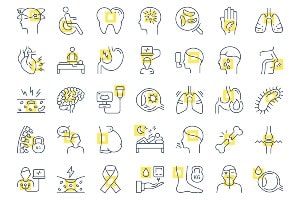About Mammogram

Learn about the disease, illness and/or condition Mammogram including: symptoms, causes, treatments, contraindications and conditions at ClusterMed.info.
Mammogram

| Mammogram |
|---|
Mammogram InformationMammogram facts
Does a mammogram hurt?During a mammogram the breasts are placed on a firm flat panel and a gentle, but firm pressure is applied to the breast with another panel, resulting in compression of the breast between the two panels. This can lead to some temporary discomfort that lasts only for a few seconds. How do I prepare for a mammogram?A mammogram does not require special preparation. Women who are still having menstrual periods may find it more comfortable not to schedule a mammogram in the week prior to the expected period when breasts may be tender.Antiperspirants, deodorants, and powders should not be worn during mammography and should be removed prior to the procedure, as these substances can make interpretation of the results more difficult. Antiperspirants can cause the images to appear foggy, and powders can sometimes simulate the appearance of microcalcifications (an abnormal finding that is sometimes associated with breast cancer). How is a mammogram performed?A brief medical history and a history of specific problems related to the breast, such as pain or a palpable lump (one that is felt), is obtained prior to the mammogram. A small X-ray marker may be taped on the breast overlying the palpable lump. This will help in determining whether any other special mammogram views need to be done beyond the standard views. All jewelry and clothing in the chest and breast area are removed prior to the mammogram. The patient's breasts are then placed on a firm flat panel and a gentle, but firm pressure is applied to the breast with another panel, resulting in compression of the breast between the two panels. This compression causes a degree of discomfort that lasts only for a few seconds. The compression of the breast is necessary to obtain quality mammograms and spreads the breast tissue out so that the X-ray image displays the inner breast tissue with good resolution. If compression is not used, the mammograms may be blurry, breast tissue may not be well delineated, and small lesions can be overlooked.Antiperspirants, deodorants, and powders should not be worn during mammography and should be removed prior to the procedure, as these substances may make interpretation of the results more difficult. Antiperspirants can cause the images to appear foggy, and powders can sometimes simulate the appearance of microcalcifications (an abnormal finding that is sometimes associated with breast cancer).Generally, two X-rays are obtained of each breast. More views may be obtained if the breasts are large, the woman has had a breast augmentation, or there is an area on the initial mammography views that needs to be further examined. Special magnified or localized mammograms of a specific area of the breast can then be done.A radiology technologist is responsible for performing mammography. Once the X-ray pictures are taken, they are developed and examined by a radiologist (a doctor who specializes in the interpretation of X-rays and other imaging studies). In most mammography centers, these radiologists have also had extra training dedicated to interpreting mammograms. How much does a mammogram cost?Medicare, Medicaid, and most private insurance companies generally cover the cost of mammography. How will I receive the results of my mammogram??The results of the mammogram can be given to the patient either by the radiologist at the completion of the mammogram or by the patient's doctor who ordered the mammogram. In many cases, it will be by both doctors. In some cases, the patient will receive a card in the mail with the results of the mammogram. The report of the mammogram generally takes a few days to reach the referring doctor. However, when there is a suspicious area on the mammogram or if additional images are needed, this information is usually relayed directly to the referring doctor or patient by phone so that further evaluation of this area can be done expeditiously. A patient should call the doctor if she has not received the results of a mammogram in a reasonable period of time. The patient should not just assume the mammogram was normal. What are the risks of mammography?Because X-ray procedures use radiation, there is some small risk of radiation side effects to the body. The amount of radiation that is administered in mammography is exceptionally low and is approved by national and international regulatory agencies as well as the National Department of Health and Human Services. In fact, the average radiation exposure from a mammogram is less than what one would receive as a passenger on a transcontinental jet flight. However, patients who are pregnant or may be pregnant are advised to notify their requesting practitioner and radiology staff, because radiation can pose a risk to the developing fetus. What if I have breast implants?You should inform the mammography facility that you have breast implants at the time you make your appointment. Breast implants can also make the traditional images obtained in mammography more difficult to interpret, and mammography should be performed by a center with experience in performing mammography on patients with breast implants for best results. What if my mammogram is abnormal?Do not panic if you are told that your mammogram is abnormal or that there is a "spot" on your mammogram. An abnormal mammogram does not mean you have cancer. The overwhelming majority of abnormal mammograms are caused by benign (harmless) processes. In some cases, it may just be an area of thicker or denser breast tissue, a cyst, or a benign lump such as a fibroadenoma. When a mammogram detects a suspicious area, the patient may be advised to obtain further mammograms of that area, to have an ultrasound or other imaging study of the breast, to see a specialist in diseases of the breast (this is usually a general surgeon), or to have a biopsy performed of the suspicious area.A breast biopsy is the removal of a piece of breast tissue for examination under a microscope. The biopsy can be performed surgically, in which an incision is made and the area removed, or it can be done as a stereotactic core biopsy. Stereotactic core biopsy is a technique of removing samples of the suspicious area without the need of traditional surgery. In this technique, the doctor, with the aid of a special mammography machine and a computer, can identify precisely the abnormality in the breast and then obtain very thin core samples of breast tissue with a special needle. This biopsy test is done with only a local anesthetic in the area of the needle puncture and is generally painless.Fortunately, most breast biopsies give benign results. While mammography alone is not sufficiently accurate to diagnose or exclude breast cancer, it is currently the best method available to screen for breast cancer. Since its more widespread routine use, breast cancers are found when they are significantly smaller and more curable. More women are surviving breast cancer as a result of mammography and early cancer treatment. Continued use of routine mammography should be encouraged until a better alternative in breast cancer detection has been found. What is a mammogram?A mammogram is an X-ray test that produces an image of breast tissue on film. This technique, called mammography, is used to visualize normal and abnormal structures within the breasts. Mammography, therefore, can help in identifying cysts, calcifications, and tumors within the breast. It is currently the most efficient screening method to detect early breast cancer. Physical examinations typically find breast cancers when they are much larger than those detected by mammography.Mammography can be used to discover a small cancer in a curable stage; however, it is not foolproof. Depending a woman's age and other factors, approximately ten to fifteen percent of breast cancers are not identified by mammography, and these cancers are often found by physical examination. It is important for a woman to perform monthly BSE and have a breast examination by her doctor in addition to the mammogram in order to most effectively screen for breast cancer.The American Cancer Society recommends that a woman obtain her first baseline mammogram at the age of 40. After that, she should receive a yearly mammogram. Women who are at high risk for developing breast cancer may need to obtain mammograms earlier than these recommendations and at more frequent intervals. Medicare, Medicaid, and most private insurance companies generally cover the cost of mammography. When should I get my first mammogram, and what are the breast cancer screening guidelines?Various organizations have differing recommendations regarding the timing and frequency of mammography.
|
More Diseases
A | B | C | D | E | F | G | H | I | J | K | L | M | N | O | P | Q | R | S | T | U | V | W | X | Y | Z
Diseases & Illnesses Definitions Of The Day
- Eating, Emotional (Emotional Eating) ‐ Emotional eating facts, How do health care providers diagnose emotional eating? …
- OTC Drugs for Constipation (Laxatives For Constipation) ‐ Are laxatives safe to take during pregnancy or while breastfeeding? …
- Hyopgonadism, Primary (Low Testosterone (Low T)) ‐ How do you know if you have low testosterone (Low-T)?, Should I take testosterone? …
- Poisoning, Ciguatera (Ciguatera Poisoning) ‐ What are the symptoms of ciguatera poisoning?, What is ciguatera poisoning? …
- Head and Neck Cancer ‐ Head and neck cancer facts*, How are head and neck cancers diagnosed? …
- XXY Males (Klinefelter Syndrome) ‐ Klinefelter syndrome facts*, Language development, Physical development …
- Devic's Syndrome ‐ How is neuromyelitis optica diagnosed?, Neuromyelitis optica facts* …
- Myocarditis ‐ How is myocarditis diagnosed?, What are symptoms of myocarditis? …
- Cancer of the Testis (Testicular Cancer) ‐ After testicular cancer has been diagnosed, tests are done to find out if cancer cells have spread within the testicles or to other parts of the body. …
- Chronic Rhinitis ‐ Chronic rhinitis and post-nasal drip definition and facts, Does salt water or nasal irrigation have any role in the treatment of rhinitis and post-nasal drip? …